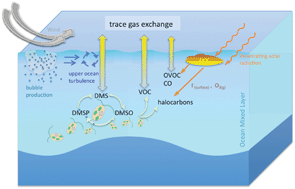Ocean-atmosphere trace gas exchange†
Abstract
The oceans contribute significantly to the global emissions of a number of atmospherically important volatile gases, notably those containing sulfur, nitrogen and halogens. Such gases play critical roles not only in global biogeochemical cycling but also in a wide range of atmospheric processes including marine aerosol formation and modification, tropospheric ozone formation and destruction, photooxidant cycling and stratospheric ozone loss. A number of marine emissions are greenhouse gases, others influence the Earth's radiative budget indirectly through aerosol formation and/or by modifying oxidant levels and thus changing the atmospheric lifetime of gases such as methane. In this article we review current literature concerning the physical, chemical and biological controls on the sea-air emissions of a wide range of gases including dimethyl sulphide (DMS), halocarbons, nitrogen-containing gases including ammonia (NH3), amines (including dimethylamine, DMA, and diethylamine, DEA), alkyl nitrates (RONO2) and nitrous oxide (N2O), non-methane hydrocarbons (NMHC) including isoprene and oxygenated (O)VOCs, methane (CH4) and carbon monoxide (CO). Where possible we review the current global emission budgets of these gases as well as known mechanisms for their formation and loss in the surface ocean.

- This article is part of the themed collection: Atmospheric chemistry

 Please wait while we load your content...
Please wait while we load your content...